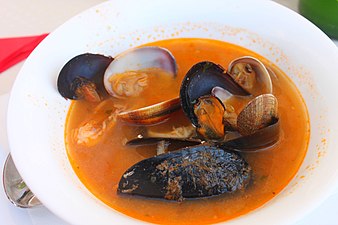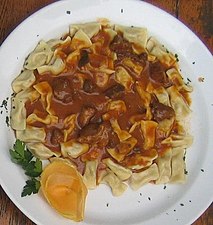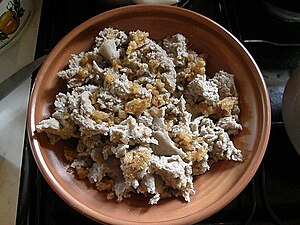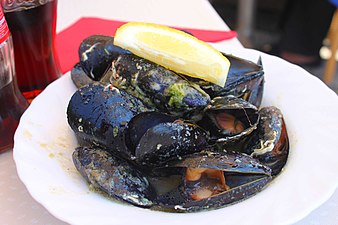
The kitchen Slovenia is influenced by Austrian, Italian and Hungarian cuisine, Yugoslav and Mediterranean cuisine are also represented. From the Alps to the Mediterranean, from the Karst to the Pannonian Plain - the different cuisines are mixed and often result in unusual but always very tasty dishes.
background
It is said that there are over 1200 national dishes and more than 100 different soups in Slovenia.
Appetizers
In addition to ham and cheese, olives and sausages are also popular as starters.
- The one dried by the bora wind Pršut - Ham is more common on menus than Karst ham Kraški pršut offered.
- Fried frog legs Žabji kraki with lemon and tartar sauce are a specialty from the region Ljubljana.

Pršut with melon

Fried frog legs Žabji kraki with lemon and tartar sauce
Soups (Juhe)
- The Iota is a soup-like soup that is widespread in many varieties in the area from Friuli in Italy to the Slovenian Karst to Istria. You can almost always find a base made from beans, potatoes with smoked meat, seasoned with garlic, bay leaves, salt and pepper.
- Bujta repa is a traditional stew made from beet, pork and millet from the Prekmurje region.
Iota
- Goveja juha is a beef soup
- Gobova juha v kruhovi posodi is called the mushroom soup in a loaf of bread
- Čebulna juha, an onion soup
- Ribja juha, Fish soup, not just on the coast
Ribja juha - a fish soup as a starter

Buckwheat soup with mushrooms

Bučna juha - pumpkin soup
Main courses
The side dishes are ordered separately with the main dishes, which results in a multitude of options. When making a selection, it can be helpful to seek advice.
- Matevž is a Slovenian national dish, typical of central Slovenia, especially the Kočevsko region. It is made from potatoes and beans with onions. It is often served with steamed sour beets and, if desired, with meat or bratwurst.
.jpg/317px-Matevž_(Slovenian_cuisine).jpg)
Matevž
Beef (Govedina)
- Beef steak with porcini mushrooms Biftek z jurčki, Beef steak in green pepper sauce Biftek v omaki zelenega popra
- Roast beef with onions Čebulna bržola
Calf (Teletina)
- Filled breast of veal Telečja Polnjena prsa
- veal roast Telečja pečenka
- Veal knuckle Telečja krača
- Veal schnitzel Telečji zrezki
Pig (svinjina)
- Svinjska pečenka, Roast pork
- Svinjska krača, Pork
- Svinjski zrezki, Pork schnitzel
- Bujta repa is a traditional Slovenian beet stew. It is made with fatty parts of the head and skin of pork and with sour beet, and millet porridge is also often used as an additional ingredient.
- Kmečka pojedina (Eng. Farmer's Feast) consists of smoked pork, ham, as well as sauerkraut and boiled sour beets. Boiled potatoes, beans and mushrooms are served as side dishes. Depending on the region, fried pork, various types of sausage or bacon may also be included.
Poultry (Perutnina)
- Turkey schnitzel Puranovi zrezki
- Fried chicken Ocvrti piščanec, a half polovička
Game (Divjačina)
- Venison steak with cranberries Jelenov zrezek z brusnicami
- Game goulash Divjačinski golaž
Horse
- Horse gulasch Konjski golaž
- Foal steak Žrebičkov zrezek

Foal steak Žrebičkov zrezek with štruklji
Side dishes
There are a large number of different side dishes in Slovenian cuisine, most of which have to be ordered separately.
- Štruklji are a Slovenian national dish, a kind of curd cheese strudel. They are served as an accompaniment to roasts. But there are also sweet variants. It is a strudel dough that is not baked, but boiled.
- Salted štruklji - Slani štruklji
- Njoki are small dumplings made from potato dough, similar to Italian gnocchi, they are also served as a side dish.
- Žlikrofi are dumplings, similar to Italian ravioli, they are also served as a side dish.
- polenta is a porridge made from cornmeal or buckwheat
- Ajdovi žganci, Buckwheat sterz, also known as "Heidensterz", is a cereal porridge made from buckwheat, a knotweed plant. The simple dish consists of buckwheat flour, greaves and oil. It is traditionally served with sausage, stew or sauerkraut.
Štruklji
Žlikrofi
Ajdovi zganci
- Krompir -Potatoes
- Ocvrt krompirček - French fries
- Pečen krompirček - Fried potatoes
- Zelenjava - Vegetables
- Kislo zelje - Sauerkraut
- Riž - Rice, used not only as a side dish, but also in risotto
dessert
- Palačinke Like the Austrian pancake, it is a thin omelette with a sweet filling
- Pancakes with jam Palačinke z marmelado
- Pancakes with chocolate Palačinke s čokolado
- Pancakes with nuts Palačinke z orehi

Palačinke
Sweets
- Potica, (Eng. Reindling) is a roll cake made from yeast dough that is reminiscent of a nut roll. Potica is the most typical sweet dish in Slovenia. There are more than 80 different varieties, with walnut, tarragon, cracked bacon or poppy seed potica being popular.
- Belokranjska povitica is a traditional round, spiral cake. The dough is made from flour, water, salt and 1/2 teaspoon of vinegar and must rest for half an hour. Then it is rolled out and stretched out as thinly as possible. The filling consists of quark, eggs, whipped cream, oil and butter. It is distributed evenly on the dough, rolled up and placed in a spiral in a greased baking pan.
- Prekmurska Gibanica is a strudel-like cake filled with quark, poppy seeds and apples, or a puff pastry with apples, nuts, raisins and ricotta.
- Dražgoški Kruhek are handmade gingerbread cookies in various shapes and decorations made from honey dough with spices. They are popular as gifts and keepsakes.
- Ajdnek is a buckwheat cake filled with honey and nuts
.jpg/374px-Potica_(9501040588).jpg)
Potica with nuts
Prekmurska gibanica
Dražgoški Kruhek
- They are a regional specialty Original Bled cream slices, Blejska kremšnitathat are freshly prepared every day by the Parkhotel's pastry shop. Every cafe and restaurant in Bled and the environment offers them.
.jpg/300px-Bled_Cremeschnitte_(blejska_kremšnita).jpg)
Bled cream slices
Sausage (klobasa)
- Black pudding with sauerkraut and buckwheat ore - Krvavica z zeljem in ajdovimi žganci
- Cereal sausages - Žitna klobasa are often served with sauerkraut and potatoes
- Jaglačais a pork sausage (Austrian millet sausage), it is filled with millet and meat
- Čmar is a stuffed pig's stomach.
- Carniolan sausage - kranjska klobasa The Slovenian name is registered as a geographically protected indication. The sausage consists of coarse sausage meat with at least 68% pork, 12% beef and a maximum of 20% bacon. Only 5% water, table salt, garlic and pepper are allowed as additives. Cheese krainers make up 10-20% cheese and were invented in Austria in 1971.

Kranjska klobasa
miscellaneous
- A meat specialty is Prleška tünka - Prlekija-style bucket meat. Pieces of pork are pickled and smoked or scalded, then seared, cooled and placed in wooden tubs and poured over with liquid minced meat and thus preserved, the meat remains particularly tender and juicy. It is served thinly sliced with black bread, onion and bell pepper. The manufacturers of Prleška tünkaThose who meet the requirements will receive a certificate and must label their products with the product name Prleška tünka, with the uniform logo in the form of a wooden container tünka mark.
Fish (ribe)
Especially in the south, by the sea, there is excellent fresh fish, which is often offered grilled with lots of garlic.
- Postrv - Trout
- Oslic - Hake
- Anchovy - sardine
- Pedoci - Mussels
- Jastog - lobster
- Škampi - Scampi
Here is a selection of fish dishes:
- Ribja Juha - Fishsoup
- Anchovy na žaru - grilled sardines with garlic, a main course
- Lignje na žaru - grilled squids, also stuffed, a main course
- Ščuka s fižolom - pike with beans
Pedoci - Mussels, another starter

Anchovy na žaru - Grilled sardines with garlic, a main course

Lignje na žaru - Grilled squids, also stuffed, a main course
Ribja plošča- A fish platter for several people
beverages
Wine (vino)

Slovenia is a real wine country that rivals the best wines in the world. Red wine means vino rdece'White wine is called vino belo.
Types of wine
- The Cviček is a Slovenian specialty. It has been protected by the EU as a regional quality product. It is a mixture of up to fourteen different red (approx. 65%) and white (approx. 35%) wines. Žametovka and Welschriesling make up the main components of the mixture. It has a refreshingly sour taste and low alcohol content - so it is ideal for the summer.
- The Modra Frankinja (Blaufränkisch) is a very dry wine with a full, dark red color and a full body.
- The Laški Rizling (Welschriesling) is a white predicate wine. His Spätlese is traditionally served with desserts and on festive occasions.
- Beli Bizeljčan (the white from Bizeljsko) is a dry white quality wine that is also popular as a wine spritzer Splash is drunk.
- Refošk (Refosco) is an old, down-to-earth red wine variety. It can produce outstanding wines of intense color, but often only mediocre table wines are produced. It is beneficial if the wines undergo malolactic fermentation in order to reduce the pronounced acidity. The best wines are made in the Slovenian Karst, Friuli and Istria.
Wine regions
Goriška Brda is one of the Slovenian wine-growing regions with a total cultivation area of around 1400 hectares. The main varieties are Pinot Gris (Sivi Pinot), Ribolla (Rebula), Merlot, Refosco (Refošk) and Cabernet Franc. The Tokaj becomes after the disputes with the Hungarians Sauvignonasse called.
- Goriška Brda Wine Cellar, Zadružna 9, 5212 5212 Dobrovo, Dobrovo v Brdih. Tel.: 386 5 331 01 00, Fax: 386 5 331 01 09, Email: [email protected].
Beer (pivo)
The beer is made in Slovenia pivo called, non-alcoholic beer brezalkoholno pivo, dark / light beer temno / svetlo pivo and draft beer is called točeno pivo. Whoever wants the beer small or large, says malo or veliko.
All those looking for tradition order Union and Laško. Anyone looking for something special will enjoy the taste of the various craft beers. In Slovenia you can try everything from bottom-fermented to top-fermented beers, from lager beers to various types of ale. Union and Laško are traditionally popular brands, while beers from microbreweries can be found in select pubs and at various events.
- The brewery UNION was founded in 1864.
- Light beers: Union warehouse, Union Nefiltrirano (Unfiltered)
- Dark beer: Union Nefiltrirano Temno (dark unfiltered)
- Cyclists: Union Radler Grenivka, Beer and grapefruit lemonade (50/50)
- Alcohol-free beer: Union Brezalkoholno, Union Radler 0.0 in the varieties Grenivka (Grapefruit), Bezeg (Elder) and Kumara (Cucumber)
- The brewery Laško was established in the spa town in 1825 Laško founded. The largest festival in Slovenia, the Beer and Flower Festival, also takes place there.

union
_(2)_(cropped).jpg/226px-Koper,_Slovenia_(35247533225)_(2)_(cropped).jpg)
Laško
Mixed drinks
- A Cyclist is a mixture of beer and lemonade in Slovenia too.
Spirits (spirituoze)
- The plum brandy Slivovka (Slivovitz)
- The herbal liqueur Pelinkovac from Petovia Ptuj has about 25% alcohol. It has a very bitter taste and is made on the basis of wormwood. Liqueurs with similar names and tastes are also made in neighboring countries.
- In the Charterhouse of Pleterje, is there Pleterje, a pear that grows in a bottle and is filled with pear brandy and the monastery spirit, a fruit brandy refined with 49 herbs.
Alcohol-free (brez alcohols)

- Cockta is a lemonade in which the main ingredient is rose hips. It was an attempt in Yugoslavia to compete with Coca-Cola in the 1950s and is still successful on the market today.
- Coffee - Kava
- Coffee with cream - Kava s smetano
- Milk coffee - Bela kava
- Milk - Mleko
- Tea - Čaj
- Tea with milk - Čaj z mlekom
- Fruit tea - Sadni čaj
- Water - Voda
- Mineral water - Mineralna voda
- Juice - Sok
ingredients

Pumpkin seed oil (bučno olje)
The nutty aroma of the dark viscous oil (in Vienna it is called Wagenschmiere) is unsurpassed, no salad should do without it, pumpkin seed oil is only unsuitable for heating, but there are enough uses for cold dishes.
No visitor should forget to shop for pumpkin seed oil. When buying, you have to make sure that you are buying 100% everything, there are also many dilutions on the market.
Salt (sol)

Salt is produced in salt pans on the short stretch of the Mediterranean coast.
- The salt pans of Sečovlje were mentioned as early as the 13th century
- At the Pirans District Strunjan you can find the northernmost still managed salt pans in the Mediterranean
Stopping off
The inn is called in Slovenian gostilna
- Inn - gostišče
- Restaurant - restavracija
- Rest house - počivališče, obcestno gostišče
- Buffet - bife
- Coffee shop - kavarna
- Pastry shop - slaščičarna
Meals (obroki)
- Breakfast - Zajtrk
- Having lunch - Kosilo
- Dinner - Večerja
Culinary calendar
Culinary delights are often seasonal. Fruits and vegetables are tastier when they are ripe; meat and fish are also subject to seasonal influences. Every season of the year, festivals are celebrated that have a general theme or focus on certain foods. There are also drinking and eating habits throughout the year that arose from religious traditions such as fasting times.
January
February
March
- From mid-March to October every Friday from 8 a.m. to 10 p.m. on the central market square Pogačarjev trg in Ljubljana the pleasure market Odprta kuhna - Open kitchen hosted. Slovenian chefs cook live and sell the food at stalls.
April
- Every Friday takes place in Ljubljana from 8 a.m. to 10 p.m. the pleasure market Odprta kuhna - Open kitchen instead of.
May
- Every Friday takes place in Ljubljana from 8 a.m. to 10 p.m. the pleasure market Odprta kuhna - Open kitchen instead of.
June
- Every Friday takes place in Ljubljana from 8 a.m. to 10 p.m. the pleasure market Odprta kuhna - Open kitchen instead of.
- Early to mid-June takes place the weekends in different places of the municipality BrdaCherry Festival. Around 30,000 visitors gather for the cherry festival. A wide variety of varieties can be tried. There are cherries fresh from the tree, as jam, in a cake, or as a liqueur and schnapps.
July
- Every Friday takes place in Ljubljana from 8 a.m. to 10 p.m. the pleasure market Odprta kuhna - Open kitchen instead of.
August
- Every Friday takes place in Ljubljana from 8 a.m. to 10 p.m. the pleasure market Odprta kuhna - Open kitchen instead of.
- In Sora pri Medvodah that takes place in the middle of the month Festival kranjske klobase - Carniolan Sausage Festival instead of. With traditional delicacies and Oberkrainer music.
September
- Every Friday takes place in Ljubljana from 8 a.m. to 10 p.m. the pleasure market Odprta kuhna - Open kitchen instead of.
October
- Every Friday takes place in Ljubljana from 8 a.m. to 10 p.m. the pleasure market Odprta kuhna - Open kitchen instead of.
- The Apple Festival of Kozjansko is a traditional event in the market town of Podsreda, which has been held every year in the second week of October since 2000. The event stands for the cooperation of the inhabitants of this biosphere reserve and the joint efforts to protect nature and preserve the agricultural and cultural environment in the Kozjansko region. The most characteristic are the tall orchard meadows with old apple tree varieties.
November
- The Festival of persimmons, Praznik Kakijev, takes place every year in mid-November in the parking lot in front of the Primorka restaurant Strunjan instead of. From Friday to Sunday there is a market with persimmon fruits and other typical delicacies from the area.
December
- At the Sparkling wine festival On December 26th, the glamorous crystal hall of the hotel will host Kempinski Palace Portorož more than 30 Slovenian, Croatian and Italian sparkling wine producers.
literature
Recipes
- slovenia.info Dishes and recipes







.jpg/317px-Matevž_(Slovenian_cuisine).jpg)





.jpg/374px-Potica_(9501040588).jpg)


.jpg/300px-Bled_Cremeschnitte_(blejska_kremšnita).jpg)






_(2)_(cropped).jpg/226px-Koper,_Slovenia_(35247533225)_(2)_(cropped).jpg)
